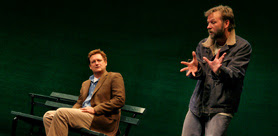On Friday evening I went to see the movie
Lions for Lambs, the film Robert Redford directed which stars (along with
Redford) Tom Cruise and Meryl Streep. Reviews I’d read had agreed that it was heavy on a liberal view of the war against terrorism, but had given ranged in evaluations from it’s being “a well-made movie” asking “many important questions” to it’s being a “preachy, immobile” film.
What I was hoping for in the film was that it would begin to examine the issues with a depth beyond the two party Republican-Democrat, hawk-dove position – either something more along the lines of a “Wag the Dog” type film or a new way to approach the current political situation.
What Lions for Lambs turned out to be was more of a series of talking heads –Cruise (a young conservative) lecturing Streep, Redford (playing a college professor) lecturing a student—with some scenes showing an attack on Afghanistan interspersed, all in an attempt to deliver a tired, liberal message that has already been presented too many times. The acting wasn’t great. Cruise didn’t even stand the way those who have graduated from West Point do, much less present any depth to his conservative position. And when Redford asked the student he was lecturing in his office why the young man had stopped attending class and why he wasn’t more actively involved in the political science discussions and in volunteering, I kept wanting to answer for him “because you’re a rambling, boring old fool who has no connection with the realities of today’s world and so why would I waste my energy on you or what you’re suggesting I do!” Each time Redford took a breath and began a new part of the (one-sided) conversation, I had all I could do to hold myself in my chair rather than, on behalf of the student, walking out of the lecture and the theater.
Luckily, as I left the movie theater, I kept in mind that on Saturday afternoon I would be going down to Manhattan’s Second Stage Theater to see Peter and Jerry, a play in which Edward Albee pairs two of his one acters—Homelife, a piece written in 2001, with Albee’s first real play The Zoo Story (perhaps my all-time favorite Albee work, though much more recently written The Goat is a close runner up), written in 1958. Albee and his caustic wit would surely cure me of the blasé feeling I carried away from Lions for Lambs.

Homelife in many ways seemed to me a toned down version of Who’s Afraid of Virginia Woolf? with a husband (Peter) and wife (Ann) politely exploring how their lives spent in an Upper West Side bourgeois setting have been civilized, predictable, complacent, and—when push comes to shove- much less than satisfactory, at least for the wife. Ann explains to her husband that he is "gentle, and thoughtful, and honest, and good -- oh, that awful word!” and that she yearns once in a while to experience the chaotic, animal madness she hopes still survives somewhere inside this bland, nice man she’s been with for years. Albee means for Homelife to explain and deepen the character of the “vegetable” Peter who is fairly silent through most of The Zoo Story. While I’ve never felt the need for such an explanation—leaving that to the details Albee provided in the Zoo Story such as the pipe and Peter’s job publishing texts had always seemed enough for me—it makes what was a subtext of the older play much more explicit.

Does it work? It does, though Homelife is much weaker than the strong writing in The Zoo Story. And, though Bill Pullman (who I thoroughly enjoyed back in 2002 as the lead in The Goat, playing Peter in both acts) and Joanna Day (Ann) are both excellent actors, Dallas Roberts as Jerry takes the day. At one point during the beginning of his story-telling of “Jerry and the Dog”, the cell phone of someone in the audience went off and Roberts stopped, keeping up the energy of his semi-psychotic, prowling character while glaring toward the sound until the ringing stopped. Because of Roberts’ powerful acting and the much more highly charged interactions in The Zoo Story, Act 2 of Peter and Jerry is what makes the performance memorable and worthwhile!

















































